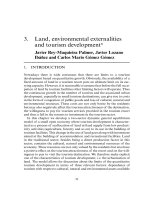THE ECONOMICS OF MONEY,BANKING, AND FINANCIAL MARKETS 489
Bạn đang xem bản rút gọn của tài liệu. Xem và tải ngay bản đầy đủ của tài liệu tại đây (32.36 KB, 1 trang )
CHAPTER 17
Tools of Monetary Policy
457
This mechanism is designed to increase the supply
of high-quality securities that could be used for collateral by banks. It can also be
used to swap less-liquid securities for more-liquid securities that the banks are
putting up as collateral. It is also designed to partially offset the temporary increase
in assets in the Bank s books associated with the term purchase and resale transactions.
TERM SECURITIES LENDING
Advantages
and Disadvantages of the
Bank s Lending
Policy
Although the Bank of Canada s role as the lender of last resort has the benefit of
preventing bank and financial panics, it does have a cost. If a bank expects that
the Bank of Canada will provide it with advances when it gets into trouble, it will
be willing to take on more risk knowing that the Bank of Canada will come to the
rescue. The Bank of Canada s lender-of-last-resort role has thus created a moral
hazard problem similar to the one created by deposit insurance (discussed in
Chapter 11). Banks take on more risk, thus exposing the deposit insurance agency,
and hence taxpayers, to greater losses. The moral hazard problem is most severe
for large banks, which may believe that the Bank of Canada and the CDIC view
them as too big to fail ; that is, they will always receive Bank of Canada emergency lending assistance when they are in trouble because their failure would be
likely to precipitate a bank panic.
Similarly, Bank of Canada actions to prevent financial panic may encourage
financial institutions other than banks to take on greater risk. They, too, expect the
Bank of Canada to ensure that they could get loans if a financial panic seemed
imminent. When the Bank of Canada considers using the lending weapon to prevent panics, it therefore needs to consider the trade-off between the moral hazard
cost of its role as lender of last resort and the benefit of preventing financial panics. This trade-off explains why the Bank of Canada must be careful not to perform its role as lender of last resort too frequently.
The most important advantage of the Bank of Canada s lending policy is that
the Bank can use it to perform its role of lender of last resort and stabilize the
financial system in times of stress. Experiences in the 1980s and early 1990s, the
Black Monday crash, the terrorist destruction of the World Trade Center, and the
recent global financial crisis indicate that this role has become more important in
the past couple of decades.
In the past, Bank of Canada advances were used as a tool of monetary policy,
with the bank rate changed to affect interest rates and the money supply.
However, because the decisions to take out loans are made by banks and are
therefore not completely controlled by the Bank of Canada (while open-marketbuyback operations are completely controlled by the Bank of Canada), using lending policy to conduct monetary policy has advantages. This is why the Bank of
Canada moved to the current channel/corridor system of monetary control in
which the bank rate is not used to set the overnight rate, but is only a backup facility to prevent the overnight interest rate from moving outside the operating band.









